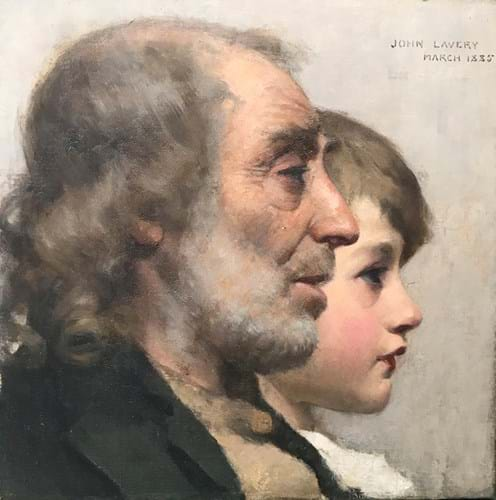
The consignor, “an elderly man living in Preston”, was hoping to sell the picture by the Belfast-born Lavery (1856-1941) in Whyte’s ‘Irish & International Art Sale’ in Dublin on December 2.
The oil on canvas, titled Youth and Age and dated 1885, is estimated to be worth around €20,000 (£17,800).
However, as Whyte’s began its research, it emerged the painting was one that had been stolen from Stonyhurst College in Lancashire.
The firm’s managing director Ian Whyte told ATG: “When we received the painting two weeks’ ago, my son Peter found it listed in Kenneth McConkey’s book on Lavery [John Lavery: A painter and his world, published 2010] where it was said to be in Stonyhurst College’s collection.
“I contacted Ken and he informed me that it was stolen about 25 years ago.”
Irish fraud squad alerted
Whyte’s then alerted Ireland’s art fraud squad, the Garda art and antiques unit, as well as the school.
Stonyhurst’s museum curator, Jan Graffius, happened to be in Dublin in late September and identified the picture as the one stolen.
"The consignor is a person in England, who says he bought it 20 years ago in an antique shop, now closed, which was located not far from the school," said Whyte.
The auction house is awaiting collection of the painting by the Irish art fraud team for handing over to Lancashire police. “We hope that it will be returned to its rightful owner shortly. Whyte’s is delighted to have assisted in its recovery.”
‘Glasgow boy’
The painting dates from a time when Lavery was a member of the influential Glasgow Boys group of artists.
Orphaned at a young age, he lived with various relatives in Co Down, Ireland and in Ayrshire in Scotland.
In 1879 he opened his own studio in Glasgow, which was destroyed in a fire, with the insurance money enabling the young artist to study in London.
His big break on the road to becoming a renowned, London-based portraitist and society painter came in 1888. That year, he was commissioned to record the visit of Queen Victoria to the Glasgow International Exhibition.
He set up a studio in Kensington and became vice-president of the newly-formed International Society of Sculptors, Painters and Gravers.
Travelling extensively, Lavery was particularly drawn to Morocco – the subject of many of his works.
Irish roots
Lavery’s Irish oeuvre includes a painting of Michael Collins, a leading figure in Ireland’s struggle for independence who was assassinated in 1922, lying in state (now at the Hugh Lane Municipal Gallery of Modern Art). Lavery and his wife, Lady Hazel Lavery, had befriended Collins during independence negotiations in London in 1921.
In 1924 Lavery was appointed a governor of the National Gallery of Ireland.
One of Lavery’s most iconic Irish works is a portrait of his wife depicted wearing an Irish shawl, commissioned in 1928, which adorned Irish banknotes for more than 50 years. It hangs in Ireland’s National Gallery in Dublin.
Lavery died in Co Kilkenny in the Republic of Ireland in 1941.





